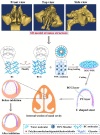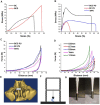Design and characterization of plasticized bacterial cellulose/waterborne polyurethane composite with antibacterial function for nasal stenting
- PMID: 33365145
- PMCID: PMC7748449
- DOI: 10.1093/rb/rbaa029
Design and characterization of plasticized bacterial cellulose/waterborne polyurethane composite with antibacterial function for nasal stenting
Abstract
A nasal stent capable of preventing adhesions and inflammation is of great value in treating nasal diseases. In order to solve the problems of tissue adhesion and inflammation response, we prepared plasticized bacterial cellulose (BCG) and waterborne polyurethane (WPU) composite with antibacterial function used as a novel nasal stent. The gelation behavior of BCG could contribute to protecting the paranasal sinus mucosa; meanwhile, the WPU with improved mechanical property was aimed at supporting the narrow nasal cavity. The thickness, size and the supporting force of the nasal stent could be adjusted according to the specific conditions of the nasal. Thermogravimetric analysis, contact angle and water absorption test were applied to investigate the thermal, hydrophilic and water absorption properties of the composite materials. The composite materials loaded with poly(hexamethylene biguanide) hydrochloride maintained well antibacterial activity over 12 days. Animal experiments further revealed that the mucosal epithelium mucosae damage of BCG-WPU composite was minor compared with that of WPU. This new type of drug-loaded nasal stent can effectively address the postoperative adhesions and infections while ensuring the health of nasal mucosal, and thus has an immense clinical application prospects in treating nasal diseases.
Keywords: bacterial cellulose; biocompatibility; nasal stent; polyurethane.
© The Author(s) 2020. Published by Oxford University Press.
Figures








Similar articles
-
Application of Eco-Friendly Waterborne Polyurethane Composite Coating Incorporated with Nano Cellulose Crystalline and Silver Nano Particles on Wood Antibacterial Board.Polymers (Basel). 2020 Feb 11;12(2):407. doi: 10.3390/polym12020407. Polymers (Basel). 2020. PMID: 32054017 Free PMC article.
-
Bio-Based Hydrogel and Aerogel Composites Prepared by Combining Cellulose Solutions and Waterborne Polyurethane.Polymers (Basel). 2022 Jan 5;14(1):204. doi: 10.3390/polym14010204. Polymers (Basel). 2022. PMID: 35012224 Free PMC article.
-
Superhydrophobic film from silicone-modified nanocellulose and waterborne polyurethane through simple sanding process.Int J Biol Macromol. 2023 Mar 31;232:123431. doi: 10.1016/j.ijbiomac.2023.123431. Epub 2023 Jan 24. Int J Biol Macromol. 2023. PMID: 36702039
-
One-Pot Processing of Regenerated Cellulose Nanoparticles/Waterborne Polyurethane Nanocomposite for Eco-friendly Polyurethane Matrix.Polymers (Basel). 2019 Feb 18;11(2):356. doi: 10.3390/polym11020356. Polymers (Basel). 2019. PMID: 30960340 Free PMC article.
-
Advances in Waterborne Polyurethane-Based Biomaterials for Biomedical Applications.Adv Exp Med Biol. 2018;1077:251-283. doi: 10.1007/978-981-13-0947-2_14. Adv Exp Med Biol. 2018. PMID: 30357693 Review.
Cited by
-
Nanocelluloses Reinforced Bio-Waterborne Polyurethane.Polymers (Basel). 2021 Aug 25;13(17):2853. doi: 10.3390/polym13172853. Polymers (Basel). 2021. PMID: 34502892 Free PMC article.
-
Flexible Waterborne Polyurethane-Bacterial Cellulose Films for Real-Time Physiological Monitoring.Polymers (Basel). 2025 Mar 16;17(6):787. doi: 10.3390/polym17060787. Polymers (Basel). 2025. PMID: 40292660 Free PMC article.
References
-
- AI Badaai Y, Samaha M.. Outcome of endoscopic sinus surgery for chronic rhinosinusitis patients: a Canadian experience. J Laryngol Otol 2010;124:1095–9. - PubMed
-
- Andrade FK, Alexandre N, Amorim I. et al. Studies on the biocompatibility of bacterial cellulose. J Bioactive Compatible Polym 2013;28:97–112.
-
- Côté DWJ, Wright ED.. Triamcinolone-impregnated nasal dressing following endoscopic sinus surgery: a randomized, double-blind, placebo-controlled study. Laryngoscope 2010;120:1269–73. - PubMed
-
- Durand M, Guellec SL, Pourchez J. et al. Sonic aerosol therapy to target maxillary sinuses. Eur Ann Otorhinolaryngol Head Neck Dis 2012;129:244–50. - PubMed
-
- Eifler J-M, Seitz CM, Weber S, Grundke. et al. MgNd2 alloy in contact with nasal mucosa: an in vivo and in vitro approach. J Mater Sci: Mater Med 2016;27:1–18. - PubMed
LinkOut - more resources
Full Text Sources

